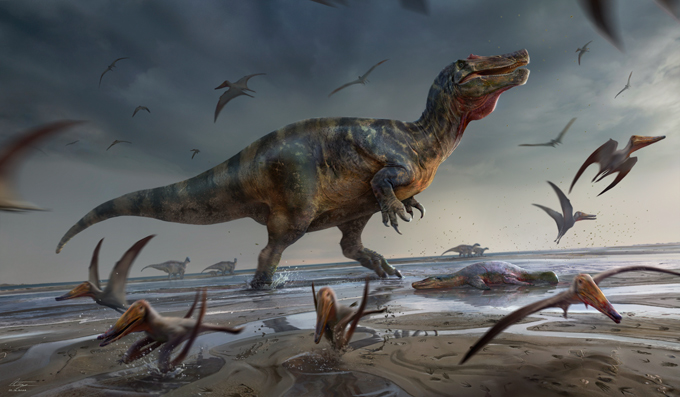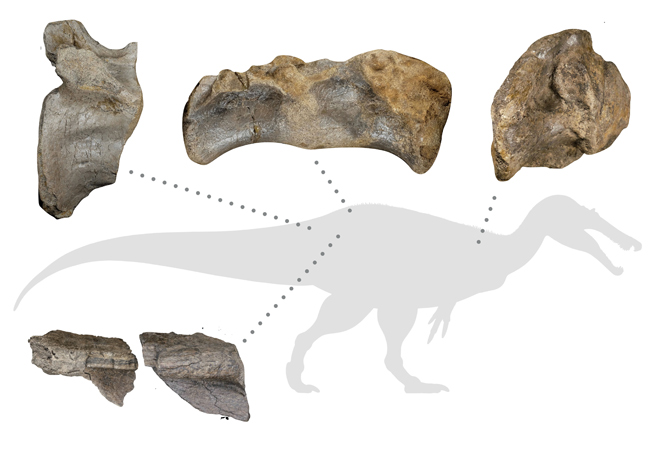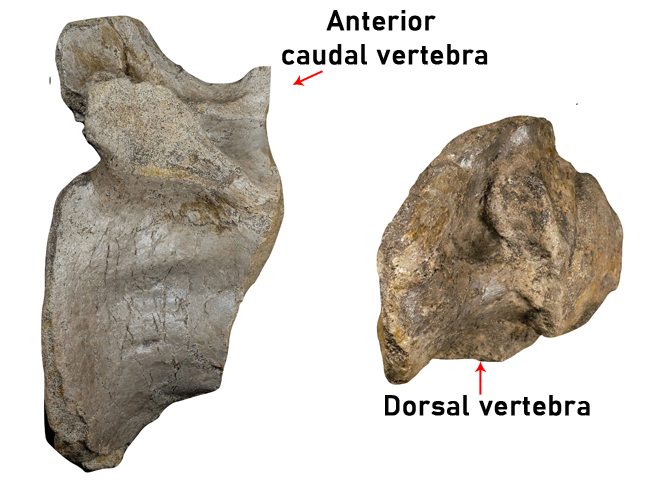Super-sized Carnivorous Dinosaur from the Isle of Wight
A newly published scientific paper has described the fragmentary remains of a super-sized theropod dinosaur unearthed on the Isle of Wight. With an estimated length exceeding 10 metres, the fossils could represent the largest carnivorous dinosaur found in Europe.
The fragmentary nature of the fossilised bones means that a more precise identification and the establishment of a new genus is not currently possible, although the fossils do probably represent a new taxon.

Illustration of White Rock spinosaurid. Picture credit: University of Southampton/Anthony Hutchings.
Picture credit: University of Southampton/Anthony Hutchings
Europe’s Largest Land Predator – A Member of the Spinosauridae
Based on anatomical traits identified from these weathered and damaged bones (they may have been trampled by other dinosaurs), the researchers are not able at this time to assign this specimen to a specific branch of the spinosaurid family tree, instead the material is classified at the family level of taxonomy and assigned to the Spinosauridae.
Commenting on the significance of this discovery, PhD student and lead author of the scientific paper Chris Barker (University of Southampton) stated:
“This was a huge animal, exceeding ten metres in length and probably several tonnes in weight. Judging from some of the dimensions, it appears to represent one of the largest predatory dinosaur ever found in Europe – maybe even the biggest yet known. It’s a shame it’s only known from a small amount of material, but these are enough to show it was an immense creature.”
Not “Europe’s Largest Ever Land Dinosaur”
Although massive and the largest theropod currently known from the Wealden Supergroup and based on bone measurements, potentially the largest theropod dinosaur found in Europe to date, Everything Dinosaur team members have noted inaccuracies in news articles. Some media outlets have declared that these fossils represent “Europe’s largest ever land dinosaur”. This is not true, fossils assigned to the Sauropoda, including several specimens from the Isle of Wight indicate, that there were many, much larger dinosaurs present in the Early Cretaceous of Europe when spinosaurids roamed.

Position of the best preserved bones. Although the material was collected from the foreshore over a period of several months, their large size suggest they all originated from a single skeleton. Picture credit: Chris Barker and Dan Folkes.
Picture credit: Chris Barker and Dan Folkes
The “White Rock Spinosaurid”
Nicknamed the “White Rock spinosaurid” after the geological layer in which it was found (the basal unit [the White Rock Sandstone equivalent] of the Vectis Formation near Compton Chine, on the southwest coast of the Isle of Wight), the fossils are around 125 million years of age (Barremian stage of the Lower Cretaceous).
It represents the first documented spinosaurid from the Vectis Formation of the Isle of Wight, extending the temporal span of the clade in the British fossil record to the late Barremian.
Dr Neil Gostling (University of Southampton), commented:
“Unusually, this specimen eroded out of the Vectis Formation, which is notoriously poor in dinosaur fossils. It’s likely to be the youngest spinosaur material yet known from the UK.”

Close views of the fragmentary spinosaurid fossil material. Anterior caudal vertebra (left) and a partial dorsal vertebra (right). Picture credit: Chris Barker with additional annotation by Everything Dinosaur.
Picture credit: Chris Barker with additional annotation by Everything Dinosaur
Dinosaur remains are generally very rarely found in the Vectis Formation, although these deposits represent sandflats and lagoonal environments where dinosaurs roamed and spinosaurid fossils have been found in other strata laid down in similar palaeoenvironments.
Vertebrate palaeontologist and co-author of the scientific paper Darren Naish commented:
“Because it’s only known from fragments at the moment, we haven’t given it a formal scientific name. We hope that additional remains will turn up in time. This new animal bolsters our previous argument – published last year – that spinosaurid dinosaurs originated and diversified in western Europe before becoming more widespread.”
The researchers hope to cut thin sections in some of the fossil remains to look at the microscopic internal properties of the bones. This may provide information about the growth rate of this dinosaur, its age and maturity.
Marks on the bone also showed how, even after death, the body of this giant probably supported a range of scavengers and decomposers.
Co-author and PhD student Jeremy Lockwood (University of Portsmouth and the London Natural History Museum), added:
“Most of these amazing fossils were found by Nick Chase, one of Britain’s most skilled dinosaur hunters, who sadly died just before the Covid epidemic. I was searching for remains of this dinosaur with Nick and found a lump of pelvis with tunnels bored into it, each about the size of my index finger. We think they were caused by bone eating larvae of a type of scavenging beetle. It’s an interesting thought that this giant killer wound up becoming a meal for a host of insects.”
The Youngest Spinosaurid Known from the UK
The fossils also represent the youngest spinosaurid known from the UK and it is most likely a new taxon but a lack of convincing autapomorphies in the fossil material found to date has prevented a more precise taxonomic classification.
Southampton University researchers were prominent in a 2021 study that described two other spinosaurs Riparovenator milnerae and Ceratosuchops inferodios, from the Isle of Wight. Both these dinosaurs come from the older Wessex Formation that underlies the Vectis Formation, so they would have been alive several million years before the “White Rock spinosaurid” evolved.
To read about R. milnerae and C. inferodios: Two New Spinosaurids from the Isle of Wight.
Everything Dinosaur acknowledges the assistance of a media release from the University of Southampton in the compilation of this article.
The scientific paper: “A European giant: a large spinosaurid (Dinosauria: Theropoda) from the Vectis Formation (Wealden Group, Early Cretaceous)” by Chris T. Barker, Jeremy A. F. Lockwood, Darren Naish, Sophie Brown, Amy Hart, Ethan Tulloch and Neil J. Gostling published in PeerJ.
The Everything Dinosaur website: Prehistoric Animal Figures.

